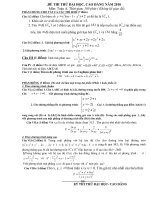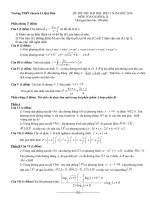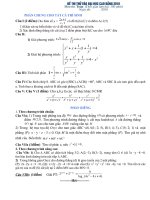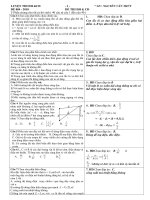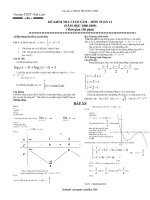ĐỀ 2. Đề thi tiếng Anh 45p + kèm đáp án chi tiết và đầy đủ nhất
Bạn đang xem bản rút gọn của tài liệu. Xem và tải ngay bản đầy đủ của tài liệu tại đây (88.49 KB, 10 trang )
ĐỀ THI TIẾNG ANH
MS: 02
Thời gian làm bài: 40 phút, không kể thời gian phát đề
Mark the letter A, B, C, or D on your answer sheet to indicate the correct answer to each of
the following questions.
Question 1: I do not believe that this preposterous scheme is _____ of our serious consideration.
A. worthy
B. worth
C. worthwhile
D. worthless
Question 2: It was difficult to guess what her ________ to the news would be.
A. feelings
B. reaction
C. capital
D. opinion
Question 3: Sportsmen __________ their political differences on the sports field.
A. take part
B. put aside
C. take place
D. keep apart
Question 4: Maria: “Can I borrow your umbrella for a day?”
Ann: “___________”
A. With pleasure
B. Ready
C. Welcome
D. Yes, I can
Question 5: When she __________ her mistake, she apologized.
A. realized
B. realize
C. was realizing
D. has realized
Question 6: _______ is to forget all about it.
A. At best you can do
B. The best thing you can do
C. What best you can do
D. You can do the best
Question 7: Harry: “May I smoke?”
Kate: “________”
A. What suits you?
B. You are free
C. Accommodate yourself!
D. Go ahead!
Question 8: Last year she earned _______ her brother.
A. twice as much as
B. twice more than
C. twice as many as
D. twice as more as
Question 9: - Can you take the day off tomorrow?
- Well, I’ll have to get _________ from my boss.
A. permission
B. licence
C. allowance
D. permit
Mark the letter A, B C or D on your answer sheet to indicate the word(s) OPPOSITE in
meaning to the underlined word(s) in each of the followingquestions.
Question 10: In 1864 George Pullman designed a sleeping car that eventually saw widespread use.
A. previously
B. ultimately
C. familiarly
D. simultaneously
Question 11: Why are you being so arrogant?.
A. snooty
B. stupid
C. humble
D. cunning
Mark the letter A, B, C, or D on you answer sheet to indicate the sentence that best combines
each pair of sentences in the following questions.
Question 12: He is very intelligent. He can solve all the problems in no time.
A. So intelligent is he that he can solve all the problems in no time.
B. He is very intelligent that he can solve all the problems in no time.
C. An intelligent student is he that he can solve all the problems in no time.
D. So intelligent a student is he that he can solve all the problems in no time.
Question 13: We cut down many forests. The Earth becomes hot.
A. The more forests we cut down, the hotter the Earth becomes.
B. The more we cut down forests, the hotter the Earth becomes.
C. The more forests we cut down, the Earth becomes hotter.
D. The more we cut down forests, the Earth becomes hotter.
Mark the letter A, B, C, or D on your answer sheet to indicate the word whose underlined part
that differs from the other three in the pronunciation in each of the following questions.
Question 14: A. great
B. bean
C. teacher
D. means
Mark the letter A, B, C, or D on your answer sheet to indicate the word that differs from the
rest in the position of the main stress in each of the following questions.
Question 15: A. weather
B. animal
C. human
D. canteen
Question 16: A. familiar
B. redundant
C. customary
D. reluctant
Read the following passage and mark the letter A, B, C, or D on your answer sheet to indicate
the correct word for each of the blanks.
NEIGHBOURS INFLUENCE BUYING DECISIONS
However objective we believe ourselves to be, most of us do not judge a product solely on its
merits, considering quality, value and style before making a decision. (34)________, we are easily
influenced by the people around us.
There is nothing wrong with this. It is probably a smarter way to make decisions than (35)
________ on only our own opinions. But it does make life hard for companies. They have long
understood that groups of friends and relatives tend to buy the same products, but understanding the
reasons has been tricky. It is because they are so similar with (36) _______ to how much money
they make and what television ads they watch that they independently arrive at the same decision?
Or do they copy one another, perhaps (37) ______ envy or perhaps because they have shared
information about the products?
Research in Finland recently found overwhelming evidence that neighbours have a big influence on
buying decisions. When one of a person’s ten nearest neighbours bought a car, the chances that that
person would buy a car of the same brand during the next week and a half (38) __________ by 86
per cent. The researchers argued that it was not just a matter of envy. Used cars seemed to attract
neighbours even more than new cars. This suggested that people were not trying to keep up with
their neighbours, they were keen to learn from them. Since used cars are less reliable, a
recommendation of one can strongly influence a buying decision.
Question 17: A. What’s more
B. Instead
C. Unlike
D. In place
Question 18: A. basing
B. trusting
C. supposing
D. relying
Question 19: A. connection B. regard C. relation D. concern
Question 20: A. for
B. as to
C. out of
D. about
Question 21: A. boosted
B. rose
C. enlarged
D . lifted
Read the following passage and mark the letter A, B, C or D on your answer sheet to
indicate the correct answer to each of the following questions from 22 to 28.
An air pollutant is defined as a compound added directly or indirectly by humans to the
atmosphere in such quantities as to affect humans, animals, vegetation, or materials adversely.
Air pollution requires a very flexible definition that permits continuous change. When the first
air pollution laws were established in England in the fourteenth century, air pollutants were
limited to compounds that could be seen or smelled - a far cry from the extensive list of
harmful substances known today. As technology has developed and knowledge of the health
aspects of various chemicals has increased, the list of air pollutants has lengthened. In the
future, even water vapor might be considered an air pollutant under certain conditions.
Many of the more important air pollutants, such as sulfur oxides, carbon monoxide, and
nitrogen oxides, are found in nature. As the Earth developed, the concentration of these
pollutants was altered by various chemical reactions; they became components in
biogeochemical cycles. These serve as an air purification scheme by allowing the compounds
to move from the air to the water or soil. On a global basis, nature's output of these
compounds
dwarfs
that
resulting
from
human
activities.
However, human production usually occurs in a localized area, such as a city. In such a
region, human output may be dominant and may temporarily overload the natural purification
scheme of the cycles. The result is an increased concentration of noxious chemicals in the air.
The concentrations at which the adverse effects appear will be greater than the concentrations
that the pollutants would have in the absence of human activities. The actual concentration
need not be large for a substance to be a pollutant; in fact, the numerical value tells us little
until we know how much of an increase this represents over the concentration that would
occur naturally in the area. For example, sulfur dioxide has detectable health effects at 0.08
parts per million (ppm), which is about 400 times its natural level. Carbon monoxide,
however, has a natural level of 0.1 ppm and is not usually a pollutant until its level reaches
about 15 ppm.
Question 22. What does the passage mainly discuss?
A. The economic impact of air pollution.
B. What constitutes an air pollutant.
C. How much harm air pollutants can cause.
D. The effects of compounds added to the atmosphere.
Question 23. It can be inferred from the first paragraph that _____.
A. water vapor is an air pollutant in localized areas
B. most air pollutants today can be seen or smelled
C. the definition of air pollution will continue to change
D. a substance becomes an air pollutant only in cities
Question 24. For which of the following reasons can natural pollutants play an important role
in controlling air pollution?
A. They function as part of a purification process.
B. They occur in greater quantities than other pollutants.
C. They are less harmful to living beings than other pollutants.
D. They have existed since the Earth developed.
Question 25. According to the passage, human-generated air pollution in localized regions
_____.
A. can be dwarfed by nature's output of pollutants
B. can overwhelm the natural system that removes pollutants
C. will damage areas outside of the localized regions
D. will react harmfully with natural pollutants
Mark the letter A, B, C or D on your answer sheet to indicate the sentence that is closest in
meaning to each of the following questions.
Question 26: "Getting a good job doesn't matter much to me "
A. "I am only interested in getting a good job." B. "It's interesting for me to get a good job."
C. "I am not good at getting a good job."
D. "I don't care about getting a good job."
Question 27: They were exposed to biased information, so they didn't know the true story.
A. If they got unbiased information, they could know the true story.
B. If they had unbiased the information, they could have known the true story.
C. If they had been exposed to unbiased information, they would have known the true story.
D. If they have exposed to the unbiased information, they could have seen the true story.
Question 28: It doesn't cost much to run a solar power system.
A. A solar power system is quite cheap to set up. B. Running a solar power system costs nothing.
C. A solar power system costs so much to run. D. Running a solar power system is not costly.
Mark the letter A, B, C, or D on your answer sheet to indicate the word or phrase that is
CLOSEST in meaning to the underlined part in each of the following questions.
Question 29: He was asked to account for his presence at the scene of crime.
A. complain
B. exchange
C. explain
D. arrange
Question 30: I’ll take the new job whose salary is fantastic.
A. reasonable
B. acceptable
C. pretty high
D. wonderful
ĐÁP ÁN VÀ GIẢI THÍCH CHI TIẾT
1A
11C
21B
2B
3B
4A
12A 13A
14A
22B 23CD 24A
5A
15D
25B
6B
16C
26D
7D
17B
27C
8A 9A 10A
18D 19B 20C
28D 29A C 30D
GIẢI THÍCH CHI TIẾT
Question 1: Chọn A
To be worthy of st: Thích hợp, đáng
Tôi không tin rằng kế hoạch ngớ ngẩn này lại phải xem xét nghiêm túc của chúng ta.
Lưu ý: 2 cấu trúc với từ WORTH, WORTHY, WORTHWHILE VÀ WHORTHLESS
Worth st: trị giá bằng cái gì.
Eg: the paintings are worth 2 milion dollars.
Worth + V-ing st: Đáng làm gì.
Eg: It is worth reading a book.
Worthy + of SB/ST: xứng đáng với ai /cái gì.
Eg: She felt she was not worthy of him
Worthwhile cũng giống như từ “worth”: worthwhile +v-ing: đáng làm gì đó.
Cấu trúc khác của worthwhile: worthwhile to do st = worthwhile for sb to do st
Worthless là tính từ ĐỒNG NGHĨA VỚI VALUELESS: KHÔNG CÓ GIÁ TRỊ và TRÁI
NGHĨA VỚI VALUABLE/PRICELESS
Question 2: Chọn B
Reaction to st: sự phản ứng đối với cái gì
Opinion about/on st = feeling about st: quan điểm về việc gì
Question 3: Chọn B
Put aside: gạt sang một bên.
Các đáp án khác không phù hợp.
Take part in: tham gia
Take place: thế chỗ
Tạm dịch: Các vận động viên gạt sự khác biệt chính trị sang một bên khi thi đấu thể thao.
Question 4: Chọn A
With pleasure: Chỉ sự đồng ý một cách lịch sự.
Tạm dịch: Mình có thể mượn ô của bạn một ngày được không? – Được thôi!
Question 5: Chọn A
Câu ghép thông thường với “when”. Tất cả đã xảy ra trong quá khứ, là một câu kể, ta chọn thì
quá khứ đơn. Tạm dịch: Khi cô ấy đã nhận lỗi của cô ấy thì cô ấy xin lỗi.
Question 6: Chọn B
Loại A vì At best: mang nghĩa là ý kiến tốt nhất, trong điều kiện tốt nhất
Loại C vì phải là what the best
Loại D vì có đến 2 động từ chính trong 1 câu
Tạm dịch: Mình có thể mượn ô của bạn một ngày được không? – Được thôi!
Question 7: Chọn D
Câu cảm thán Go ahead!: Cứ tự nhiên.
Tạm dịch: Tôi có thể hút thuốc không?- Cứ tự nhiên đi
Question 8: Chọn A
Vì “money” là danh từ không đếm được nên dễ dàng loại đáp án C. Hơn nữa đây là so sánh
bằng nên ta chọn A.
Các em lưu ý cách nói: Nhiều hơn mấy lần: Từ chỉ thứ tự (twice/third/…) + as + much/many
+N.
Tạm dịch: Năm ngoái cô ấy kiếm tiền nhiều hơn gấp đôi anh trai.
Question 9: Chọn A
Dễ dàng thấy đây phải là danh từ, trong 4 đáp án, A là phù hợp nhất
Permission (sự cho phép)
Licence (giấy phép, ví dụ: lái xe, …)
Allowance (tiền trợ cấp)
permit (v)(cho phép)
Tạm dịch: Bạn có thể nghỉ ngày mai không? Vâng, Tôi phải xin phép ông chủ đã.
Lưu ý: to take the day off: nghỉ làm (tạm thời không phải đi làm).
Question 10: Chọn A
Tạm dịch: Vào năm 1864, George Pullman đã thiết kế một chiếc xe có giường ngủ đã được sử
dụng rộng rãi.
Eventually (adv) (cuối cùng)
Previously (adv) (trước đây)
Ultimately (adv) (cuối cùng, sau cùng)
Familiarly (adv) (thân mật, không khách khí, suồng sã)
Simultaneously (adv) (đồng thời, xảy ra cùng một lúc, làm cùng một lúc)
Do đó đáp án chính xác là “previously” (đề bài yêu cầu tìm đáp án trái ngược nghĩa)
Question 11: Chọn C
Arrogant (adj) (kiêu căng, kiêu ngạo, ngạo mạn)
Snooty (adj) (khinh khỉnh, kiêu kỳ )
Stupid (adj) (ngu ngốc, ngu xuẩn)
Humble (adj) (khiêm tốn, nhún nhường)
Cunning (adj) (xảo quyệt, xảo trá)
Ta thấy câu hỏi tìm đáp án mang nghĩa trái ngược nên đáp án chính xác là “Humble” (khiêm
tốn, nhún nhường).
Question 12: Chọn A
Sử dụng cấu trúc đảo ngữ: “So + adj + to be + chủ ngữ
+ that + mệnh đề” để nhấn mạnh câu viết lại.
Question 13: Chọn A
Sử dụng so sánh kép: …càng…càng... để viết lại câu
Question 14: Chọn A
Great / greɪt / (adj) (to lớn, tuyệt vời, vĩ đại)
Bean / biːn / (n) (hạt đậu, đậu)
Teacher /'ti: tʃə / (n) (giáo viên)
Means/'miːns / (n) (phương tiện)
Đáp án chính xác là A vì phần gạch chân được đọc là âm /ei/ khác với những đáp án còn lại đọc
âm /i: /.
Question 15. Chọn D
Nhấn trọng âm ở âm tiết thứ 2, còn lại nhấn âm thứ 1.
Weather (n) (thời tiết)
Animal (n) (động vật)
Human (n) (con người)
Canteen (n) (căng tin).
Question 16. Chọn C
Nhấn trọng âm ở âm tiết thứ 1, còn lại nhấn âm thứ 2
Familiar (adj) (quen thuộc, thân thuộc).
Redundant (adj) (dư, thừa).
Customary (adj) (thông thường, theo lệ thường, thành thói quen).
Reluctant (adj) (miễn cưỡng, bất đắc dĩ, không thích).
Question 17: Chọn B
Tạm dịch: . . . However objective we believe ourselves to be, most of us do not judge a product
solely on its merits, considering quality, value and style before making a decision. (1) , we are
easily influenced by the people around us:
Cho dù bạn nghĩ mình khách quan đến mức nào thì hầu hết chúng ta đều không đánh giá một
sản phẩm đơn thuần dựa trên phẩm chất, chất lượng thực tế, giá trị và mẫu mã của sản phẩm đó
trước khi đưa ra quyết định.
, chúng ta dễ dàng bị ảnh hưởng bởi những người xung quanh.
What’s more: Hơn thế là
Instead: Thay vào đó
Unlike: không giống như
In place: Thay
Ta chọn đáp án có thể đứng làm trạng ngữ. Vì hai vế của câu trái ngược nhau nên từ này cũng
phải thể hiện được sự trái ngược đó. Đáp án A không hợp nghĩa. Đáp án C không thể đứng làm
trạng ngữ nếu không có danh từ đi kèm. Đáp án C thiếu giới từ “of”, “in place of something”
(thay cho cái gì) và cũng không đứng làm trạng ngữ. Vậy đáp án đúng phải là B.
Question 18: Chọn D
Tạm dịch:. . It is probably a smarter way to make decisions than (3) on only our own opinions
Mà đây có lẽ là cách thức khôn ngoan để đưa ra quyết định hơn là chỉ vào ý kiến cá nhân
Basing (dựa trên nền tảng, phát triển từ).
Trusting (tin tưởng)
Supposing (tin rằng)
Relying (phụ thuộc)
Cấu trúc “to rely on something”: dựa vào, phụ thuộc vào. Các đáp án khác không phù hợp về
nghĩa và không thích hợp với văn cảnh.
Question 19: Chọn B
Tạm dịch: It is because they are so similar with (4)
to how much money they make…
Có phải là bởi họ tương đồng số tiền kiếm ra…
+ Connection (đề cập tới) + Regard (liên quan đến)
+ Relation (liên quan tới) + Concern (quan ngại về) Xét các đáp án trên trong cấu trúc đều
mang nghĩa là liên quan tới, đề cập tới:
• In connection with
• With regard to
• In relation to
• To concern somebody/something
Question 20: Chọn C
Tạm dịch: Or do they copy one another, perhaps (6) envy or perhaps because they have shared
information about the products? :
Hay bởi họ bắt chước lẫn nhau, có lẽ ghen tị hoặc có lẽ do họ cùng chia sẻ thông tin về sản
phẩm?
A. for B. as to
C. out of D. about
Cấu trúc “out of envy” = because of envy: bởi sự ghen tị, do ghen tị.
Vậy đáp án C là phù hợp nhất.
Question 21: Chọn B
Tạm dịch: . . . . When one of a person’s ten nearest neighbours bought a car, the chances that
that person would buy a car of the same brand during the next week and a half (7) by 8 per cent
Khi một trong số mười người thân cận với một cá nhân mua một chiếc xe hơi thì cơ hội để cá
nhân đó cũng mua một chiếc xe nhãn hiệu tương tự trong một tuần rưỡi tới 8%.
Boosted (nâng lên, đẩy lên) (ngoại động từ)
Rose (tăng lên) (nội động từ)
Enlarged (tăng lên) (ngoại động từ)
Lifted (nhấc lên) (ngoại động từ)
Chủ ngữ là “the chances” (cơ hội). Do đó, từ cần điền phải là một nội động từ. Loại đáp án A
và C là hai ngoại động từ. Loại đáp án D không hợp nghĩa.
Do đó chỉ có đáp án B là đúng.
22.B
Đề: Bài luận bàn luận chủ yếu về vấn đề gì?
A. Tác động về kinh tế của ô nhiễm không khí.
B. Điều gì cấu thành/tạo nên ô nhiễm không khí.
C. Ô nhiễm không khí có thể gây hại nhiều tới mức nào.
D. Tác động của các hợp chất được đưa vào bầu không khí/khí quyển.
Câu mở bài: Một chất gây ô nhiễm không khí được định nghĩa là một hợp chất được đưa vào
bầu không khí/khí quyển một cách trực tiếp hoặc gián tiếp bởi con người ở một mức độ mà
ảnh hưởng xấu tới con người, động thực vật hoặc các vật chất.
(Sau đó toàn bài đi sâu phân tích các chất gây ô nhiễm và cách chúng tạo nên ô nhiễm không
khí.)
23.C
Đề: Có thể được suy luận ra từ đoạn văn đầu tiên rằng…
A. hơi nước là một chất gây ô nhiễm không khí ở các khu dân cư
B. hầu hết các chất gây ô nhiễm không khí ngày nay có thể được nhìn thấy hoặc ngửi thấy
C. định nghĩa về ô nhiễm không khí sẽ tiếp tục thay đổi
Câu 2: “Air pollution requires a very flexible definition that permits continuous change.”
Dịch: Sự ô nhiễm không khí đòi hỏi một sự định nghĩa linh hoạt mà cho phép có sự thay đổi
không ngừng/liên tục.
D. một chất trở thành chất gây ô nhiễm không khí chỉ khi ở trong thành phố
24.A
Đề: Vì lý do nào sau đây mà các chất gây ô nhiễm tự nhiên đóng vai trò quan trọng trong việc
kiểm soát sự ô nhiễm không khí?
A. Chúng hoạt động với chức năng là một phần của quá trình thanh lọc.
B. Chúng xuất hiện với số lượng lớn hơn nhiều so với các chất gây ô nhiễm khác.
C. Chúng ít có hại tới các sinh vật sống hơn so với các chất gây ô nhiễm khác.
D. Chúng đã luôn tồn tại từ khi trái đất hình thành.
Đoạn 2: “Many of the more important air pollutants, such as… are found in nature. As the
Earth developed, the concentration of these pollutants was altered by various chemical
reactions; they became components in biogeochemical cycles. These serve as an air
purification scheme…”
Dịch: Nhiều chất gây ô nhiễm không khí quan trọng/nghiêm trọng hơn, như… được tìm thấy
trong tự nhiên. Khi trái đất hình thành/phát triển, chúng trở thành các thành phần trong các
chu kỳ sinh hoá. Chúng có tác dụng như là một cách thanh lọc không khí…
25.B
Đề: Theo bài luận, ô nhiễm không khí gây ra bởi con người ở các khu vực tập trung dân cư…
A. có thể được lấn át bởi các chất gây ô nhiễm sinh ra từ tự nhiên.
B. có thể áp đảo hệ thống tự nhiên mà (hệ thống đó) loại bỏ các chất gây ô nhiễm.
C. sẽ gây thiệt hại tới các khu vực ngoài các vùng tập trung dân cư.
D. sẽ phản ứng một cách có hại với các chất gây ô nhiễm tự nhiên.
Đầu đoạn 3: “In such a region, human output may be dominant and may temporarily overload
the natural purification scheme of the cycles.”
Dịch: Ở những vùng như vậy, khí thải do con người có thể chi phối và có thể tạm thời gây quá
tải lên sự thanh lọc tự nhiên của các chu kỳ.
Question 26: Chọn D
Nghĩa câu gốc: Getting a good job doesn't matter much to me: Việc tìm được một việc làm tốt
không có ý nghĩa với tôi lắm.
Lưu ý: sth doesn’t matter to me: không có ý nghĩa
Question 27: Chọn C
Nghĩa câu gốc: They were exposed to biased information, so they didn't know the true story:
Họ bị cung cấp thông tin sai lệch nên họ không biết được sự thật.
Câu gốc thuộc thì quá khứ nên khi chuyển sang câu điều kiện ta dùng câu điều kiện loại III: If
+ S + V(qk), S + would/could/should + have + V(qkpt)
Lưu ý: unbiased: không thiên vị
Question 28: Chọn D
Nghĩa câu gốc: It doesn't cost much to run a solar power system: Không quá tốn kém để vận
hành một hệ thống năng lượng mặt trời.
Lưu ý: set up: lắp đặt
Cost sth: tốn. Eg. cost me 50 dollars: tốn của tôi 50 dollars
Run a system, run a business, run a machine.
Question 29: Chọn C
Tạm dịch: Anh ta được đề nghị sự xuất hiện của mình ở hiện trường vụ án.
Account For (v) (giải thích, đưa lí do cho)
E.g: This accounts for his behaviour: điều đó giải thích thái độ đối xử của hắn.
Complain (v) (kêu ca, kêu, phàn nàn, than phiền; oán trách)
Exchange (v) (đổi, đổi chác, trao đổi)
Explain (v) (giải thích, thanh minh )
Arrange (v) (sắp xếp, sắp đặt, sửa soạn)
Câu hỏi tìm đáp án gần nghĩa nhất. Ta thấy đáp án chính xác và phù hợp nhất với văn cảnh là
“Explain”.
Question 30: Chọn D
Tạm dịch: Tôi sẽ chấp nhận công việc mới có mức lương .
Fantastic(adj) (tuyệt, tốt, vô cùng to lớn)
Reasonable (adj) (có lý, hợp lý)
Acceptable (adj) (chấp nhận được)
Pretty high (adj) (khá cao)
Wonderful (adj) (tuyệt vời, tốt)
Dựa vào những giải nghĩa từ vựng ở trên thì đáp án chính xác là “Wonderful”.



